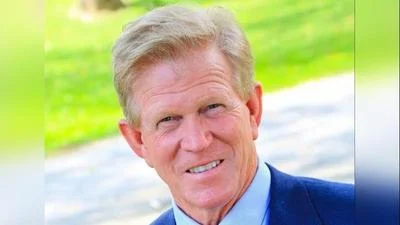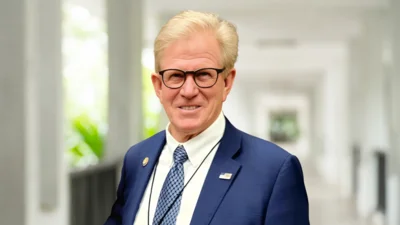City of Charleston Historic Preservation Commission met April 13.
Here is the minutes as provided by the commission:
1. Call to Order: Chair Bob Bertrand called the meeting to order at 7:59 a.m.

2. Roll Call: Present were Commissioners Bob Bertrand, Erin Blitz, Giuliana Dongu, Merry Lichtenberger, Blair Lord, Kit Morice, Peter Quinn and ex-officio members Matt Madigan and Nora Pat Small. Also present were City Clerk Deborah Muller, City Planner Steve Pamperin, and City Attorney Steve Mahrt.
3. Introduction of Guests: Present were Jeff Knezovich and Marty Morgan, representing the Central Illinois Alumni Association and a large group of 6th and 7th Street residents.
Certificate of Appropriateness (COA)—956 & 964 6th Street/Sigma Pi House, Central Illinois Alumni Association
Chair Bob Bertrand started the meeting with an overview of the duties of the Charleston Historic Preservation Commission in reviewing COAs, specifically, does the application adhere to the Secretary of the Interior’s Standards for Rehabilitation? It was also noted that letters from Historic District residents Steve and Donna Witmer and Dick and Ramona Wise had been emailed to the Clerk for distribution to the Commission. The letters were entered into the record as Exhibits A and B.
Bertrand asked City Attorney Mahrt for clarification about time limits for audience members who wished to speak about the application, to which he replied that a three minute time limit was not necessary but that speakers should stick to a specific topic and not repeat comments that others have made.
Jeff Knezovich, Treasurer, Central Illinois Alumni Association, presented a revised plan to connect the two properties with an addition that would function as a gathering space for fraternity members. He said this plan was crafted after meetings with members of the HPC and that the design would now be more of an atrium with glass front walls and not entrances or exits from the front of the addition. This would move the social space to the back of the addition to reduce noise issues during large gatherings of the fraternity.
Commissioner Nora Pat Small suggested at this point that the neighborhood representatives be allowed to speak.
Ray Carr, 101 6th Street, noted the fraternity had been a problem in the neighborhood, elaborating on various issues involving fraternity members (and others) on personal properties in the area. He stated they have not been good neighbors, holding large parties attended by 300-400 people with alcohol present. There has also been retaliation when neighbors have called police to address these issues. He stated he would prefer that they abandon the proposed addition, not put a driveway in an already congested area (Polk Avenue between 4th and 6th Streets), and rehabilitate the two properties within the footprints that exist. He also commented that much underutilized housing already exists in the area.
Sallie Cougill, 935 6th Street, stated she did not know about the earlier meeting on March 23, and had only just learned of this meeting a few days ago. She noted there was a lengthy list of neighbors who opposed the COA application, including 7th Street resident Dan Corrie, a real estate appraiser, who told her the addition would lower property values in the neighborhood. She noted that after years of decline, the historic importance of the area that has been designated as an historic district should be preserved for future generations. At this point, Sallie provided a packet of letters to the Commission written by neighbors opposing the COA. This was duly entered into the record as Exhibit C.
Jonelle DiPetro, 947 6th Street, said the mission of the HPC was to protect the integrity of the neighborhood; the proposed addition would look more like a hotel that a residence.
Lola Burnham, 1011 6th Street, said the noise factor was not addressed in the revised plan. It did not conform to the adjoining properties. She was fine with renovating the existing houses and suggested that the City consider neighbor notification when COAs of this magnitude were being presented to the HPC. The revised plan was only 46,000.00 less than the previous plan and ADA requirements could easily be met with ramps. She also reminded the HPC of their duties to preserve the character of the historic district.
Gail Mason, 860 7th Street, said the neighbors would be thrilled to see these properties renovated. She then submitted data on the Greek system at EIU in light of the declines in enrollment, which is also reflected by the numbers of students joining fraternities. The enrollment data was duly entered into the record as Exhibit D.
Dan Cougill, 935 6th Street, described efforts going back to 1993 to create a strategic plan, and later a comprehensive plan for Charleston, recognizing weaknesses in zoning and the city’s infrastructure. Part of this addressed the need for the establishment of a historic preservation ordinance and commission. He also noted his and Sallie’s own efforts to restore their front porch at great expense, and that others in the neighborhood had undertaken similar projects in their efforts to preserve their historic properties.
Kirsten Bays, 1003 6th Street, asked the HPC to look to the Standards as their guidelines for considering COAs.
Response from Jeff Knezovich: His organization sought to instill standards of conduct in their members and he would address the behavioral issues cited by neighbors. He distinguished that 964 was a rental and not currently occupied by Sigma Pi fraternity members. He stated that the trend in EIU’s Greek Court was for chapters to move out. He gave a brief history of 956 6th Street and earlier additions (c. 1910) and that Sigma Pi had been there since 1954. The redesigned addition differentiating the addition from the existing historic structures. It would provide an assembly area for social gatherings. Renovation of the existing houses would be a part of the project as well as addressing the need for a state required fire suppression system.
Commissioner Bertrand asked Knezovich what constituted a non-alcoholic fraternity. Knezovich’s response was that alcohol was not allowed inside the house. He added they were not expanding the residential capacity from 24 but would redesign the residential layout for a house mother. Bertrand asked why not put the resources into rehabilitating the houses, to which Knezovich replied the focus was to create an assembly area.
Commissioner Nora Pat Small addressed the rest of the HPC with clarification about interpreting the Standards. Specifically, she addressed the reasoning behind differentiating new additions from existing historic structures. The proposed addition would result in a loss of distinctive historic features and materials, and once they were gone, one could not restore the integrity that had been lost. Restoring the 1962 front porch to the earlier design also did not fit the Standards, noting that this topic was controversial among the preservation community. The addition did not preserve the massing of the structures, the relationships of the houses to one another in terms of set back and side yards; it destroyed the relationship of the building sizes and masses. The bay windows on both houses would be lost or obscured. The metal roofing material was not compatible with the existing materials.
Giuliana Dongu made the motion to vote on whether or not to approve the COA and Blitz seconded. The vote was thus: Bertrand, nay; Blitz, nay; Dongu, nay; Lichtenberger, nay; Lord, nay; Morice, nay; and Peter Quinn, nay—7:0. Denial of the COA was unanimous.
Meeting Adjournment: Morice made the motion to adjourn the meeting and Lord seconded.
Adjournment: 9:16 a.m.
https://www.charlestonillinois.org/vertical/sites/%7B48D19AF4-26A9-444F-A5B9-99631D71D5F2%7D/uploads/HPC_Minutes_4-13-18_(KM).pdf





 Alerts Sign-up
Alerts Sign-up